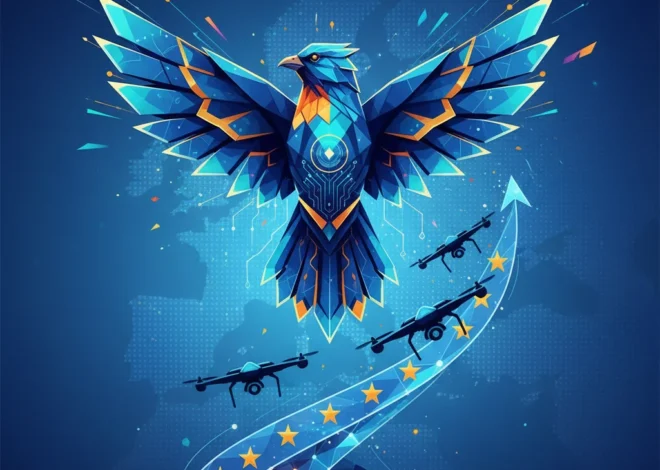
The Code War: Why Europe’s Military Needs a Silicon Valley Reboot
Modern warfare is no longer just about the size of your tanks or the speed of your jets. It’s about the speed of your code. The conflict in Ukraine has been a brutal, real-time demonstration of a new reality: victory is increasingly determined by software, data, and the ability to innovate faster than the enemy. While agile tech startups are deploying AI-powered systems on the front lines, Europe’s defense establishment is often stuck in a bureaucratic time warp, running on procurement processes designed for the Cold War.
This is the stark warning from Uwe Horstmann, the newly appointed chief executive of Stark, a German defense AI startup with backing from prominent tech investor Peter Thiel. In a recent interview, Horstmann argued that Europe is at risk of falling dangerously behind, shackled by an archaic system that favors legacy hardware giants over the very software and AI-driven innovation it needs to survive. His message is clear: it’s time for a radical rethink. This isn’t just about buying new drones; it’s about rebooting the entire operating system of European defense.
From Steel to Software: The New Battlefield Paradigm
For decades, military superiority was measured in tons of steel, firepower, and hardware specifications. A new tank or fighter jet would be developed over 15-20 years, built to last for 30, with its capabilities largely fixed on the day it rolled off the assembly line. Think of it as the Nokia 3310 of defense: incredibly durable, but fundamentally limited in function.
Today, the most advanced military systems are more like iPhones. The hardware is a platform, but the real power lies in the software—the operating system and the apps. This “software-defined” approach allows for constant updates, new features, and rapid adaptation to emerging threats. A drone’s targeting system can be improved overnight with a new machine learning model. A command-and-control network can be patched and upgraded remotely, just like a SaaS application. This is the model that US tech companies like Palantir and Anduril have successfully deployed, creating a significant technological edge.
As Horstmann points out, the current European approach is the polar opposite. He describes a system where “the process is that the military writes a 2,000-page document of what it wants…and 15 years later, a big legacy defence company delivers exactly that.” By the time the bespoke hardware is delivered, he warns, “it’s already outdated.” (source) This isn’t just inefficient; in the face of rapidly evolving threats, it’s a critical strategic vulnerability.
The Code of Life: What the Nobel Prize in Medicine Teaches Tech About Self-Regulation and AI
The Procurement Problem: A Tale of Two Systems
The core of the issue lies in the fundamental mismatch between how traditional defense ministries buy things and how modern technology is built. One is a waterfall, the other is agile. One values rigid, pre-defined specifications, the other values iterative development and continuous improvement. This clash of cultures is a major barrier to innovation.
To illustrate the difference, let’s compare the two models:
| Attribute | Traditional Procurement (“The Old Way”) | Agile, Software-First Model (“The New Way”) |
|---|---|---|
| Focus | Hardware-centric, bespoke platforms | Software-defined, adaptable systems |
| Development Cycle | 10-20 years, linear development | Months or weeks, iterative sprints |
| Updates & Upgrades | Costly, infrequent physical refits | Continuous, over-the-air software updates (SaaS model) |
| Key Technology | Mechanical engineering, materials science | Artificial Intelligence, cloud computing, automation |
| Supplier Type | Large, established defense conglomerates | Agile startups and tech companies |
| Core Principle | Build to last, meet fixed specifications | Build to adapt, evolve with threats |
Stark’s Mission: Building a European “Anduril”
This is the landscape Stark is stepping into. The company’s vision is to become Europe’s answer to Anduril Industries, the US startup that has disrupted the American defense market by building AI-powered drones and sensor systems on a software-first foundation. Stark aims to do the same, focusing on creating intelligent, autonomous systems that can be produced quickly and updated continuously.
Their approach is a direct challenge to the old guard. Instead of waiting for a 2,000-page specification document, Stark is building systems based on what is technologically possible and what modern battlefields demand. Horstmann states their goal is to provide systems where “80 per cent of the value is in the software, in the AI.” This is a radical departure from traditional hardware, where the software is often an afterthought.
The business model itself is disruptive. By leveraging a SaaS-like approach, Stark can offer a lower entry cost for its hardware, with recurring revenue generated from software updates, new capabilities, and data processing. This aligns the company’s incentives with the military’s needs: continuous improvement and staying ahead of the curve. The involvement of Peter Thiel, a co-founder of Palantir, signals a clear intent to bring a Silicon Valley mindset of aggressive growth and technological disruption to Europe’s staid defense sector.
The Tech Stack of Modern Defense
For developers, tech professionals, and entrepreneurs, this shift represents a massive opportunity. The future of defense is being built on the same technologies transforming the commercial world:
- Artificial Intelligence & Machine Learning: AI is the brain. It powers autonomous navigation, object recognition (distinguishing a tank from a tractor), predictive maintenance, and threat analysis. The quality of the programming and the sophistication of the ML models are the new differentiators.
- Cloud and Edge Computing: A modern military can’t be tethered to a central data center. It needs a hybrid model where massive datasets can be processed in the cloud for training AI models, while real-time decisions are made on “the edge”—on the drone, vehicle, or soldier’s device itself.
- Automation: From drone swarms that coordinate autonomously to automated data fusion that provides commanders with a clear picture of the battlefield, automation is key to managing complexity and accelerating the decision-making loop (known as the OODA loop: Observe, Orient, Decide, Act).
- Cybersecurity: When your entire defense apparatus runs on software, cybersecurity is no longer a feature; it’s the foundation. Protecting networks, data links, and software supply chains from state-sponsored attacks becomes one of the most critical missions. A vulnerability in code can be as devastating as a physical attack. According to one report, cyberattacks on the defense sector have seen a dramatic increase in recent years, highlighting the urgency.
Cracking the Code: How AI and Tech Startups Are Destroying 'Forever Chemicals'
The Road Ahead: A Call for Systemic Change
Horstmann’s call to action is not simply for Europe to buy Stark’s products. It’s a plea for systemic reform. For Europe to truly build a 21st-century defense capability, several things need to happen:
- Procurement Reform: Governments must create faster, more flexible contracting pathways for software and AI companies. This means moving away from rigid, multi-year tenders towards pilot programs, agile contracts, and subscription-based models.
- Embrace of Open Architecture: Instead of bespoke, proprietary systems that lock them into a single vendor for decades, militaries should demand open standards. This allows for “best-of-breed” components from various suppliers (including startups) to be integrated, fostering competition and innovation.
- Cultural Shift on Risk: The defense establishment must become more comfortable with the iterative nature of software development. This means accepting that a product might be deployed at 80% capability and improved in the field, rather than waiting 15 years for a “perfect” but obsolete system.
The war in Ukraine has shown that a military’s ability to adapt is its greatest asset. The country has leveraged commercial technology, from Starlink for communications to consumer drones modified for reconnaissance, demonstrating the power of agility. As one analysis notes, this has “accelerated the trend of the ‘software-defined’ battlefield.” (source)
All In: Why the U.S. Economy is Making a Trillion-Dollar Bet on AI
Conclusion: Adapt or Be Outdated
The message from pioneers like Uwe Horstmann is both a warning and an opportunity. Europe stands at a critical juncture. It can continue down the well-trodden path of slow, hardware-focused procurement, effectively programming obsolescence into its own defense. Or, it can embrace the software revolution, empower its tech innovators, and build a more agile, intelligent, and resilient security architecture.
The choice isn’t just about modernizing an industry; it’s about securing a future. In the 21st century, the most powerful armies won’t just be the ones with the most hardware. They will be the ones with the best code, the smartest algorithms, and the fastest update cycles. The code war has already begun, and it’s time for Europe to log in.


